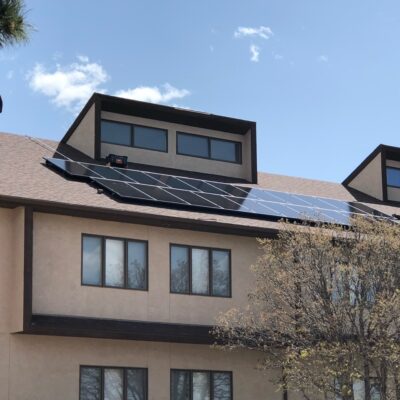The article below is an excerpt from Mennonite Creation Care Network’s forthcoming booklet entitled, Considering Solar? A Guide for Churches. The complete guide will be released by October 1, 2022. It has been updated in light of recent changes due to the Inflation Reduction Act.
Writer/researcher Karla Kauffman, West Liberty, OH, interviewed 18 Mennonite congregations and multiple solar installers while compiling the guide. Many tips and stories from churches are included. Sign up below to receive notice when the booklet is out.
Choosing, funding and installing solar panels is an intense commitment for a year or more, but churches have been pleased with the results once the task is completed. Over and over, solar congregations advised others to ‘just do it.’ They offered unanimous affirmation for their solar installations.
The most essential ingredient
Every congregation interviewed that succeeded in installing solar panels had one thing in common: a tenacious leader. This visionary raises the issue, does initial research and then pulls in others. One described himself as a Solar Evangelist; another used the term, Solar Champion. Both men and women served in this role. A few congregations had committees who shared the tenacity, and no one person was identified as the one without whom the project would not have happened.
What did these tenacious leaders do? They did not necessarily have technical or financial expertise, but they were committed to getting the installation completed. Tenacious leaders took initiative, handled early research, dealt with details, contacted people, stayed organized and persisted in hard moments. They might approach members for funding–or leave that to others.
“I was hesitant about being the leader for our project because I had none of the technical knowledge about solar–just the conviction that the time for solar has come,” said Jana Preheim from Mountain Community Mennonite Church, Palmer Lake, Colo. Despite this, she was pleasantly surprised by the overwhelming support from the congregation. Her church (pictured above) installed solar panels in 2022.
Are solar panels practical for your building?
A tenacious leader might start by looking into the following:
How long do you intend to use this building?
Are there any circumstances that would suggest a move before you have reached payback? This should be within fifteen years; more often, less. Solar panels can be moved, but it’s expensive to do that.
Hours of sunlight
Your solar output will depend on access to sunlight. You will need a south, east or west-facing roof that is shade-free from about 9 a.m. to 5 p.m. most of the year. Walk around your building and imagine what the sun’s angle will be in each season. Alternately, you will need space for a ground mount system. Solar contractors have tools that enable them to assess your site in more depth, but you can get an idea if it is worth pursuing.
Local mentors
Look around your community for solar panels. When you see another nonprofit or business who has them, stop in and ask about their process, installers and outcome.
Usage
How much does your church spend on electricity each year? What was the electric usage for the most recent 12 months and is that typical? Will this change in the future due to growth or additional carbon emissions reduction measures? These are questions a solar installer will want to know early on.
Roof and building condition
If you are considering rooftop solar, how old is your roof? Asphalt shingle roofs need replacement in about 20 years, and removing and reinstalling solar panels costs thousands of dollars. It is more cost-effective if your panels go on a roof that will last as long as they do– 25 years or more. A relatively new standing-seam metal roof is ideal. Secondly, is your roof sound enough to hold the number of panels you hope to install? Solar panels are not heavy, but you will need a general contractor to assess this early on.
Your utility
Every utility company approaches solar customers differently. You can dig into this more later, but an initial web search and one phone call to customer service can give you an idea of the programs your utility offers.
Electrical equipment
Will your building’s equipment meet current code and solar requirements? Is there more than one electric meter on your property? Later, you may need a professional to assess this for you, but it is an important question to keep in mind from the outset.
If you found no red flags above, it’s time to assemble a solar team. It is much easier if the tenacious leader has teammates. Experience with building management, finances and fundraising are all useful, but don’t overlook a generalist with good communication skills or an early adopter who has solar at home. These voices will be important, too.
Coming Soon
Sign up to be notified when Considering Solar? A Guide for Churches is ready.
